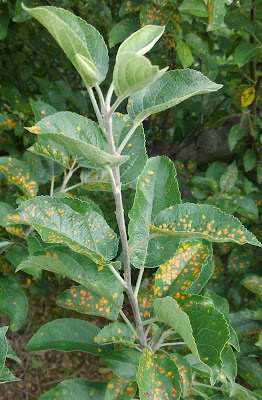Three extended wetting events at Winchester in the past week favored secondary apple scab and summer disease development. These occurred June 10-11: 10 hr of wetting at 73° with 0.23 in. rain, June 17-18: 14 hr of wetting at 65° with 0.69 in. rain and June 21: 16 hr of wetting at 65° with 0.01 in. rain. Cedar-apple rust infection on leaves over most of the length of unprotected shoots (shown below) indicates that infection occurred well into June this year, but galls have now been depleted of inoculum at Winchester AREC.
 |
| Cedar-apple rust on York Imperial apple shoot June 20, 2020. Lesions on all but the youngest leaves show that infection occurred well into June. |
Apple powdery mildew infection occurs on days without rainfall above 53°, and in the Winchester area we have had 38 days favorable for infection since spores were available on Mar 29.
Other areas of Virginia also received significant wetting events in the past two weeks, June 10-11, and especially June 14-19. Some of these were extremely long wetting periods with heavier rainfall than Winchester: Staunton June 16-19, 51 hr with 1.88 in. of rain; Roanoke three wetting periods June 14-18, totaling 65 hr and 5.75 in. rain; Batesville June 16-19, 44 hr with 1.31 in. rain; Carter Mt., June 15-18, 64 hr with 0.91 in. rain; Red Hill, three wetting periods June 13-19, totaling 54 hr and 0.9 in. rain; Lynchburg, two periods June 15-19, total 76 hr and 3.79 in. rain; Rustburg, June 14-19, two periods totaling 79 hr and 3.81 in. rain; Danville, two periods, total 67 hr and 1.8 in. rain. These long wetting periods and volumes of rainfall should be expected to increase pressure from sooty blotch and flyspeck and various fungal rot diseases.
To predict the development of the sooty blotch and flyspeck (SBFS) fungal complex, we record accumulated wetting hours (ACW) from rainfall, fog, or dew, starting 10 days after petal fall. The action threshold of 250 ACW predicts that the SBFS fungi are present on unprotected fruit when the threshold is reached, and symptoms will soon appear with further incubation. All of the monitored areas except Winchester and Sperryville have now exceeded the 250-hr threshold, and Winchester and Sperryville will likely pass the threshold in the next 7-10 days. Here is a listing of selected petal fall date and total wetting hour accumulation (ACW) for selected locations as of June 21: Winchester, May 5, 187 ACW; Staunton, May 5, 324 ACW; Roanoke, Apr 18, 316 ACW; Floyd, Apr 28, 291 ACW; Manassas, Apr 28, 257 ACW; Sperryville, Apr 28, 199 ACW; Batesville, Apr 18, 316 ACW; Crozet, Apr 18, 276 ACW; Carter Mountain, Apr 18, 435 ACW; Red Hill, Apr 18, 291 ACW; Lynchburg, Apr 13, 366 ACW; Rustburg, Apr 13, 361 ACW; Danville, Apr 13, 450 ACW.
